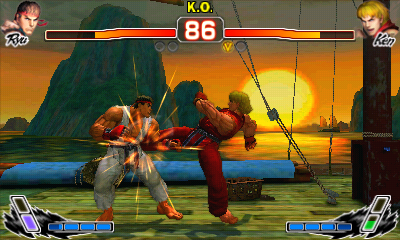
The biggest factor in reviewing a fighting game for home console is usually how faithfully the original arcade version is represented (unless the even the arcade version is terrible). I good port of a popular arcade game can be a system seller. In the 16-bit era, the Super Nintendo had a heads-up on the Genesis for first having an impressive version of Street Fighter II (1992). Sega responded with a more faithful rendition of Mortal Kombat (1993, with blood!) and Street Fighter II Championship Edition (1993). For perhaps one of the first times in the major fighting game genre, Super Street Fighter IV (2010) was first released on consoles, then arcade. This is interesting because unlike previous eras of gaming, the home console version dictated what would be in the arcade version.
Super Street Fighter IV was released on X-Box 360 and PS3 almost one year ago and quickly became the fighter of choice for tournament players around the world. I originally had my reservations about the original Street Fighter IV (2009) because the character designs looked somewhat awkward. Eventually, I came around to appreciate what the game tried to do: evoke a sense of nostalgia and familiarity from Street Fighter II, but incorporate newer gameplay mechanics and graphics. I feel that Street Fighter IV is successful in that sense, and even more, I feel Capcom has been able to please the hardcore fans and tournament players without abandoning newcomers. Super Street Fighter IV 3D Edition does even more to incorporate those new to the franchise, or like me, just plain suck at the game.
Super Street Fighter IV 3D Edition is made to impress from the moment the game starts. Using the 3D effect of the Nintendo 3DS, Capcom shows off their classic logo in style. I don’t own a home console version of Super Street Fighter IV, but from what I can tell, the 3D edition features everything you would expect a home version to have and more. Arcade, versus, and online game modes are all here as well as challenges, training, the new 3D dynamic view and figure collection modes.
Arcade mode is pretty straight forward. Choose your fighter, costume, color scheme, and ultra combo, then fight your way to Seth with the car bashing and barrel busting mini games along the way. There are anime cutscenes as you begin and end your journey, which are pretty nice. I enjoy the fact that the game has a sense of humor about the origins of some of its characters. Newcomer El Fuerte in particular comes to mind, being a luchador wrestler with special moves named after some of my favorite Mexican foods. Gameplay feels exactly like the console version. Every move and combo is represented accurately and the animation is smooth. Super Street Fighter IV 3D Edition showcases the 3DS’s graphic prowess in a grand way. Looking at the screen, I would compare the graphics level somewhere close to Gamecube level. The 3D effect is enough to wow anyone at a first glance, and I must say, I prefer playing with the 3D on. Similar to the way HD graphics enhance a game experience, when I play the game with 3D off, I feel as if something is missing. Ultimately, the 3DS’s 3D screen has no effect on gameplay, but playing Super Street Fighter IV 3D Edition without 3D make everything feel less exciting.
While in arcade mode, players have the two new gameplay options. The first is called dynamic view, aka 3D mode. Dynamic view shifts the camera from the traditional straight-on panoramic view to something more similar to Resident Evil 4 (2005) and 5‘s (2009) 3rd person angle to give a new perspective while playing the game. In dynamic view, the camera keep a constant distance behind the player’s character and only shifts when the character faces an opposite direction. Dynamic view does not chance the actual gameplay. It’s still 2D gameplay. Movement and special moves are entered the exact same way. I can’t say that I prefer this new angle, but it’s interesting to try out, especially in 3D. Dynamic view does tend to make some special moves a bit more glorious looking, but because the camera is at an angle, for me, it feels awkward to push left or right to move forward or backward. In dynamic view, directional inputs don’t quite correlate to where the character is moving. I do however appreciate that Capcom chose to create this new option because it does highlight something that would be much harder to do on a home console. Because dynamic view is tailored to one player’s perspective, unless two screens are utilized or a spiltscreen mode is created, it couldn’t be done on a home console.
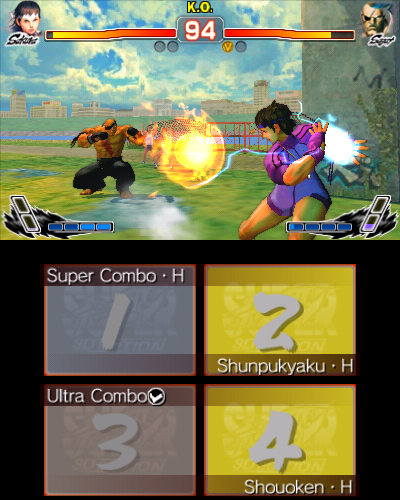
The second new gameplay option is fight request mode. If you’re not familiar with seeing the words “A New Challenger Appears”, fight request mode is a new way of incorporating versus matches while playing arcade mode. In Street Fighter II, when a player wanted to play the game while another was in arcade mode, they could interrupt the game mid-match and the magic words would appear. In Super Street Fighter IV 3D Edition, fight request mode allows players to interrupt those in arcade mode through the internet or through the 3DS’s wireless. Players have the option to turn off fight request mode to play uninterrupted, or they could be on a subway, about to get that last hit on Guile when all of the sudden someone sitting across from them challenges them to a fight. So far, if I have fight request mode turned on, I end up not being able to play through arcade mode because friends and strangers challenge me.
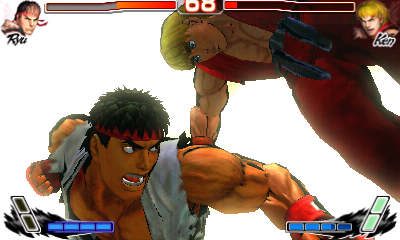
Versus mode is the setting to used when playing with another player locally, but versus mode can also be used to play against the computer, watch the computer play against itself, watch other players versus matches on a separate 3DS, or offer 3DS download play for another player who doesn’t own Super Street Fighter IV 3D Edition. Download play is a convenient solution for those who want to play against each other but are without two copies of the game. Unfortunately, the player that downloads the game is only allowed to play as Ryu. Similar solutions have been present within handhelds for a while now, and I believe it is a fair solution. It’s interesting that the game allows players to watch the computer compete against itself. I’m not quite sure what the point would be, but I guess if a player is tired of playing and would just like to watch, there’s a mode for them. But then again, wouldn’t attract mode do the same thing? I think one of the most interesting versus mode options is the ability to watch a pair of players match locally. Since Super Street Fighter IV 3D Edition is at most a two player game, if a group of an odd number were to convene, the odd man out could at least view a match in their own screen in 3D. It’s not a groundbreaking option, it’s a small, but smart addition to an already impressive list of additions.
Online play aka internet match feels very similar to the way Capcom set up online play for Tatsunoko VS Capcom: Ultimate All-Stars (2010) on the Wii. After finishing a match online, players have the option to rematch, choose a new character, or disconnect. For every match a player wins, the player earns battle points, which help determine the player’s ranking. While playing through the game in its various modes, players unlock achievements, images, and titles. The images appear next to a player’s online handle, and range anywhere from a cute baby chicken to a pissed off Akuma. The titles appear next to the photo and state various exclamations such as “Let’s fight!” to “I like bean jam.” Custom online matches can be created which are important, especially to the Street Fighter veterans and experts. Custom match allows for players to choose specific filters for their matches. Those players playing with the pro-mode control scheme will likely want to play with other players using the same. Lite-mode control is a bit of a conundrum. Through lite-mode control, players have the ability to map any specific special move or combo to any button they wish. With a character like Seth, every single button, including the four touch screen buttons can be turned into a special move or combo. For beginning and novice players, this may be a godsend, but unfortunately it takes away from one of the key components in such a competitive game: skill. It’s difficult to say if this will foster a certain play-style or if players will use it as a stop gap as their skills improve. Either way, again, those using pro-mode controls have the option to play with others also using the same.
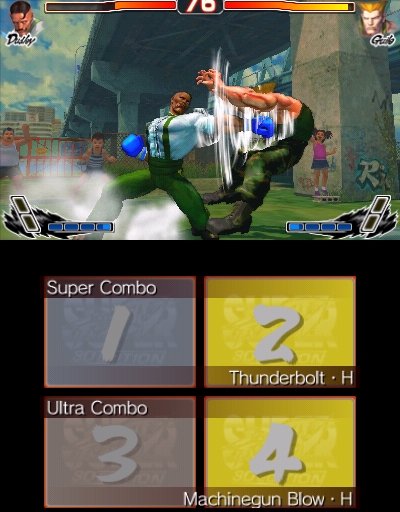
Figure collection mode is my favorite new addition to the game. Using the 3DS’s street pass capabilities, players can engage in a unique way to battle other players with figures. The figures themselves are represented as something similar to gashpon toys, and each has its own levels and stats. Players can create a team of figures, but a limit of 20 levels cannot be exceeded between 5 figures. Figures can be purchased using Player Points, which can be earned through winning matches online or through arcade mode. Player Points can also be purchased using 3DS play coins (play coins are earned though walking while the 3DS is in sleep mode). Figures can also be unlocked through special codes distributed by Capcom. Just this week, Capcom sent a Spot Pass notification through the 3DS that featured a code for a level 7 gold colored Blanka figure. Once a player has their chosen team and street pass activated, they have the ability to participate in a Super Street Fighter IV 3D Edition street pass battle, which for some might be easier said than done. This feature in particular is reliant on people other than the player to also own a 3DS and a copy of Super Street Fighter IV 3D Edition. There is no online mode for the figure battles, but that’s kind of what makes it fun. At the end of a day when I have had my 3DS on me all day and I find that I’ve encountered a street pass figure battle, I feel as if I’ve been rewarded in some way. Figure collection mode is addicting. Like Pokemon (1998), there is a desire to collect every figure. For Capcom, it’s a way of including new features and functionality that only the 3DS can deliver. For players, it’s another way to be rewarded for playing the game continually.
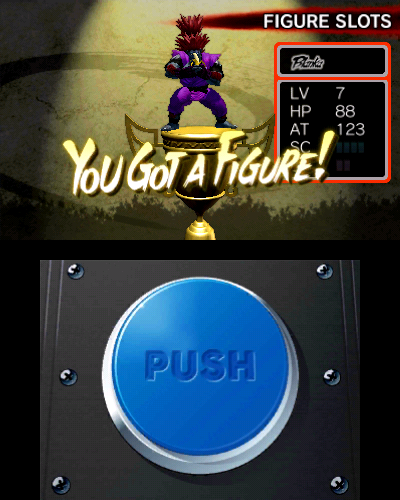
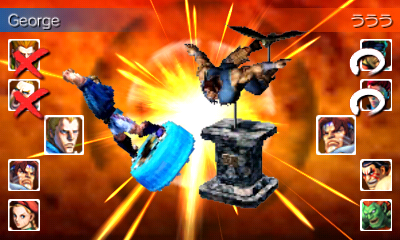
Super Street Fighter IV 3D Edition is the most impressive handheld fighting game I’ve ever played. Although purists would argue that handheld systems are hardly an ideal or desired method for playing fighting games, I feel that Super Street Fighter IV 3D Edition could impress even some of the most hardcore players out there. Considering the graphical quality, gameplay options, gameplay quality, and functionality, Super Street Fighter IV 3D Edition is hands down the must have game from the 3DS launch. No other launch title uses as many of the features that the 3DS offers as Super Street Fighter IV 3D Edition. This is a showcase game that I show to my friends whenever I show them my 3DS and it always impresses. If you don’t already own this, you need to get it now. If you already own a home console version of this game, I still believe it’s well worth a purchase because in the end, this is essentially a portable version of Super Street Fighter IV, and that is awesome.
